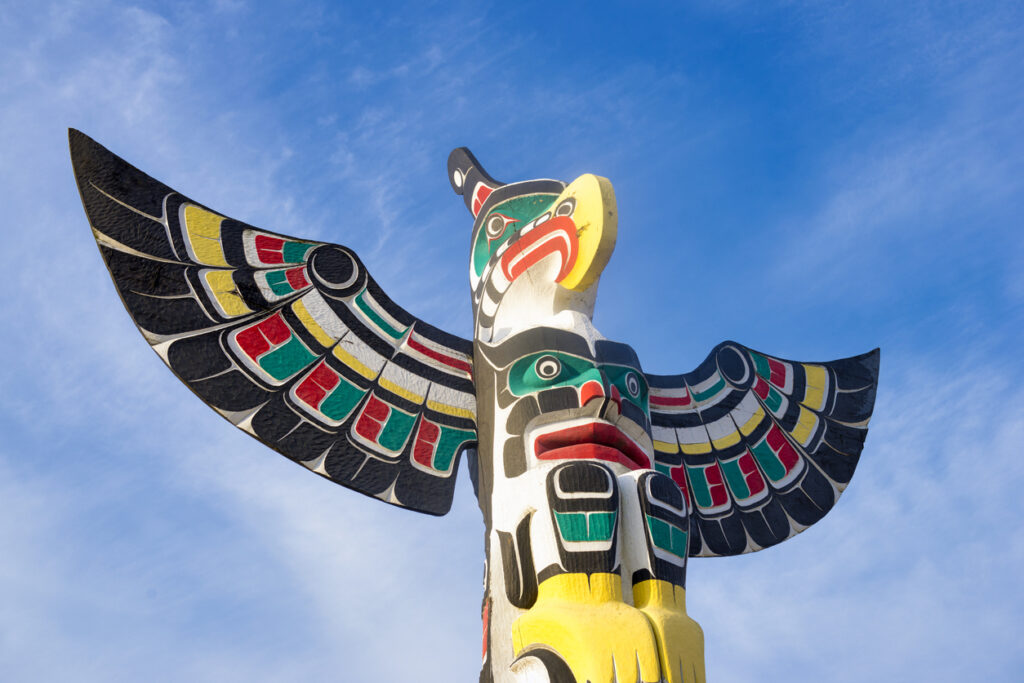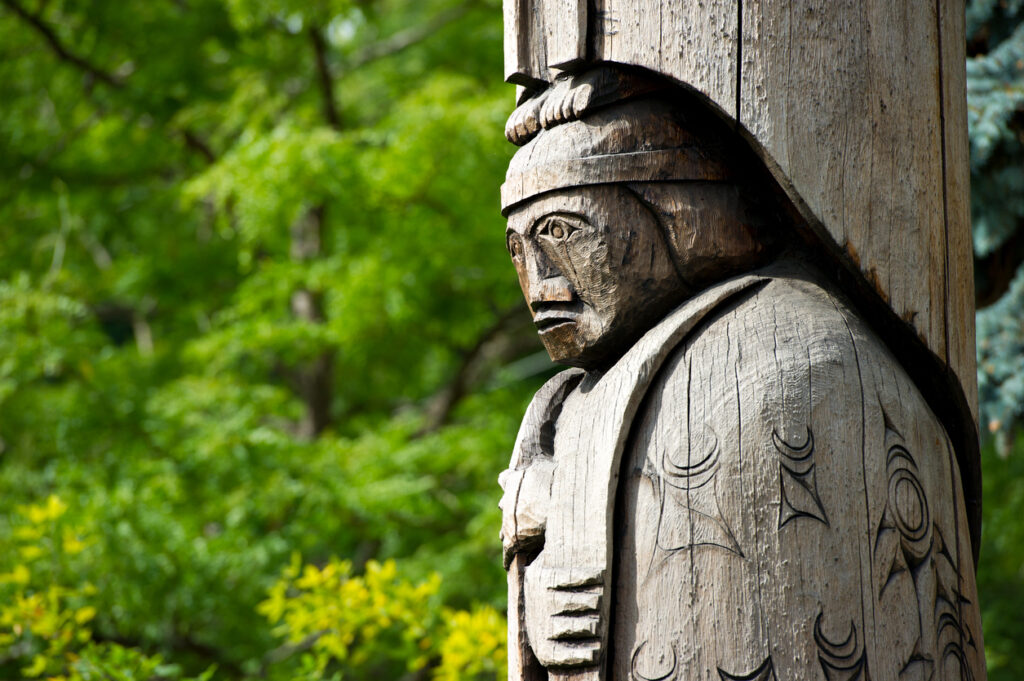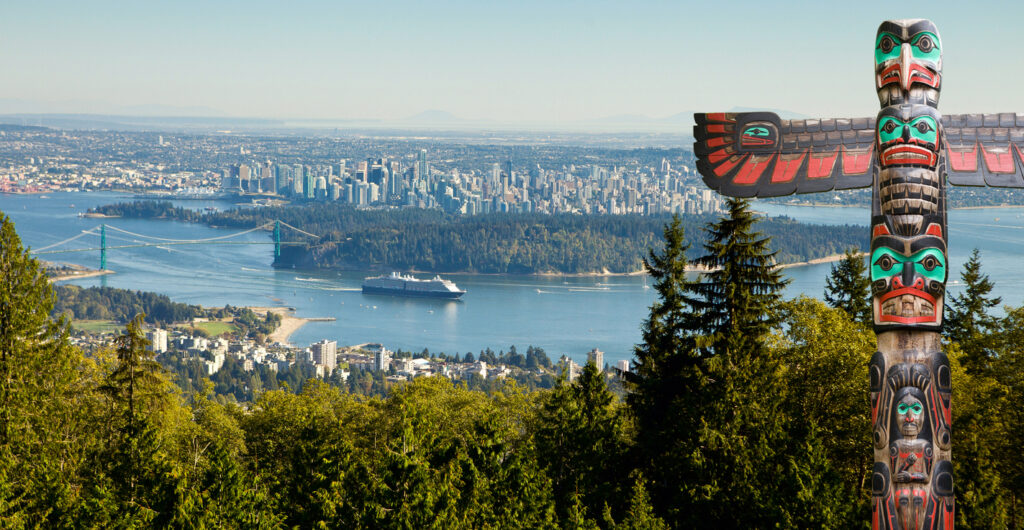British Columbia is a land of towering mountains, lush forests and a deep-rooted Indigenous history. Among the most striking and significant cultural landmarks in the province are totem poles – magnificent, carved wooden monuments that tell stories, honour ancestors and mark important events. These structures, created primarily by the Indigenous peoples of the Pacific Northwest, hold profound historical, cultural and artistic significance. For visitors to British Columbia, seeing these towering works of art firsthand offers a glimpse into the rich traditions of the First Nations and their enduring presence on this land.

Photo by iStock
The History & Meaning Of Totem Poles
Totem poles have been crafted by Indigenous peoples of the Northwest Coast, including the Haida, Tlingit, Tsimshian, Nuu-chah-nulth, Kwakwaka’wakw and Coast Salish nations, for centuries. Contrary to early misconceptions, totem poles were never objects of worship. Instead, they serve as historical records, commemorative monument, and artistic expressions that depict family lineage, mythology and significant events.
The word “totem” is derived from the Ojibwe word doodem, meaning “clan” or “kinship group,” but in British Columbia, totem poles take on a distinct meaning rooted in the traditions of the coastal First Nations. They were historically carved from massive western red cedar trees, chosen for their durability and spiritual significance. The figures carved into these poles represent animals, humans, supernatural beings and symbols that carry specific meanings unique to each family or nation.
Different types of totem poles exist, including:
Heraldic poles: Displaying a family’s lineage and rights to land, names and privileges.
Mortuary poles: Containing the remains of a chief or important person in a carved compartment.
House poles: Placed at the entrance of homes to signify status and lineage.
Shame poles: Raised to shame individuals or groups who had committed a misdeed; these could be removed if amends were made.
Commemorative poles: Raised to honour a particular event or individual.

Photo by iStock
The Decline & Revival Of Totem Pole Carving
During the 19th and early 20th centuries, colonial policies, including the Potlatch Ban (1885 to 1951), suppressed Indigenous cultural practices, leading to a decline in totem pole carving. Many poles were stolen or sold to collectors and museums worldwide. However, with the resurgence of Indigenous pride and cultural revitalization in the late 20th century, carving traditions were revived. Today, Indigenous artists continue to create totem poles, blending traditional techniques with contemporary storytelling.
Where To See Totem Poles In British Columbia
For visitors eager to experience these awe-inspiring structures, British Columbia offers numerous locations where totem poles can be admired in their traditional and modern settings.
Stanley Park, Vancouver
One of the most visited sites in British Columbia for totem poles is Brockton Point in Stanley Park. This collection of totem poles, assembled from various Indigenous communities, represents the artistry of First Nations across the province. The site, with its breathtaking coastal backdrop, provides an accessible introduction to totem pole heritage and Indigenous history.

Photo by iStock
Museum of Anthropology, Vancouver
Located at the University of British Columbia, the Museum of Anthropology (MOA) houses an extensive collection of Indigenous art, including towering totem poles inside its Great Hall. The museum also has outdoor exhibits showcasing original and replica poles. MOA’s extensive interpretive materials help visitors understand the cultural context of each carving.
Royal BC Museum, Victoria
In the heart of British Columbia’s capital, the Royal BC Museum features the First Peoples Gallery, which displays impressive totem poles alongside Indigenous artifacts and cultural exhibitions. Just outside the museum, Thunderbird Park presents a remarkable outdoor collection of totem poles, including some that have been carefully restored or replicated by master carvers.
Haida Gwaii
For those seeking an immersive cultural experience, Haida Gwaii (formerly the Queen Charlotte Islands) is a must-visit destination. Home to the Haida Nation, the islands feature historical and contemporary totem poles, including those in SGang Gwaay Llnagaay (Ninstints), a UNESCO World Heritage Site known for its standing mortuary poles. The Haida Heritage Centre in Skidegate also offers exhibitions and carving demonstrations that bring the history of these poles to life.

Photo by iStock
Alert Bay & U’mista Cultural Centre
Located on Cormorant Island, Alert Bay is home to the world’s tallest totem pole, standing at 173 feet. The U’mista Cultural Centre houses a collection of repatriated Indigenous artifacts, including totem poles, masks and regalia. This community is an excellent place to learn about Kwakwaka’wakw traditions and witness contemporary carving practices.
Totem Pole Trail, Victoria
Beacon Hill Park in Victoria boasts several striking totem poles, including one of the world’s tallest free-standing totem poles, carved by Kwakwaka’wakw artist Mungo Martin. The park’s scenic landscape provides a serene environment for appreciating these towering works of art.
Northern British Columbia: Prince Rupert & Kitwanga
In northern BC, Prince Rupert’s Museum of Northern British Columbia houses impressive Indigenous artifacts, including totem poles. The nearby Totem Park in Gitwangak (Kitwanga) features historic poles that tell the stories of the Gitxsan people. The area is rich in Indigenous history, with sites that showcase traditional village layouts and heritage structures.
Conclusion
Totem poles are more than just artistic masterpieces; they are enduring symbols of Indigenous identity, storytelling and resilience. British Columbia’s diverse collection of totem poles offers visitors a chance to engage with the rich cultural traditions of the First Nations who have lived on this land for thousands of years. Whether seen in a bustling urban park, a secluded coastal village or a museum dedicated to Indigenous heritage, these magnificent carvings continue to stand tall as testaments to the history, artistry and spirituality of the Pacific Northwest.
For travelers looking to deepen their understanding of totem poles, visiting these sites with Indigenous-led tours or cultural guides provides a meaningful and respectful way to appreciate the stories these poles tell. In every carving, a history is preserved, and by witnessing them firsthand, visitors become part of that ongoing story.

Photo by iStock
Research for this article was done with the assistance of OpenAI

